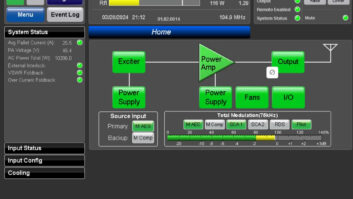LAS VEGAS The National Radio Systems Committee voted on RF AM and FM mask compliance guidelines for IBOC at its meeting concurrent with the NAB Show in April.
The technical standards-setting body also has revived its RBDS Subcommittee.
The 90+ page IBOC measurement guideline is titled “NRSC-G201, NRSC-5 RF Mask Compliance: Measurement Methods and Practice.” It provides detailed instructions on best practices for determining RF mask compliance for the situations most likely to be experienced by stations and manufacturers.
The idea is to minimize variation so results are consistent, David Maxson of Broadcast Signal Labs, told Radio World; he shepherded much of the work.

What the IBOC RF measurement guideline does. Maxson said the guidelines represent more than two years of labor and a collaborative effort by many sectors of the industry including broadcast engineers, test and measurement and broadcast equipment manufacturers, engineering consultants, contract engineers and others.
Consistency sought
“We need repeatable measurements, and no gold standard existed,” said Maxson when asked why the industry needs IBOC measurement guidelines.
Different testers of the same systems achieved varied results, even when using the same equipment. Results are dependent on equipment used and settings, as well as how a signal was sampled. In a perfect world, all gear works the same, he said.
“We’re trying to get quality control and interference control if we adhere to the AM and FM mask,” he said. Having a reliable and repeatable way to evaluate IBOC emissions will be important if the proposed FM power increase is approved, he said.
The guidelines should help measure one station’s interference with another.
NRSC Chairman Milford Smith, vice president of radio engineering with Greater Media, said the RF guidelines would quantify spectral re-growth.
Looking towards the future, “The FCC has not yet adopted technical standards for IBOC,” Maxson told Radio World, noting that the commission is using specs it received from iBiquity in 2002, with periodic updates from the technology company. He hopes the commission will see the guidelines as something it can rely on to create IBOC technical standards.
The IBOC Standards Development Working Group, chaired by Dom Bordonaro, chief engineer of Cox Broadcasting Connecticut, crafted the document. The working group is a part of the Digital Radio Broadcasting Subcommittee, which adopted the guidelines. Andy Laird, vice president and chief technology officer of Journal Broadcast Group, and Mike Bergman, vice president of new digital technologies at Kenwood USA, co-chair the DRB.
The guidelines were to be posted soon on the NRSC Web site (www.nrscstandards.org).
Meanwhile, the revived RBDS Subcommittee has some 36 members, according to Chair Barry Thomas of Lincoln Financial.
Europe has updated its data standard and the subcommittee is looking at whether it should incorporate those changes in the U.S. standard.
For example, Europe has 13 codes to describe radio formats in its standard, too few for this country.
One of the items the group is looking at is whether there should be a standard for AM RDS. Also, Thomas said Steve Davis of Clear Channel is chairing a working group to help broadcasters deploy RDS.







